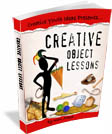ADVANTAGES
- Objects attract and hold the attention of observers
- Objects can help simplify complex ideas and concepts.
- The high interest level extends to all age groups even though they are usually used with children.
- Retention is very good due to the high interest as well as the identification of the truth with the object.
- Object lessons turn people’s “eyes into ears.” Because people think in terms of words and images, objects help them recall what is taught.
- Object lessons are fairly easy to use in a class and elaborate equipment is not necessary
- The student is given first-hand experience by coming into contact with the object
- Because of nature of object lessons, the teacher will develop the habit of graphic, colorful portrayal of truth which will make all teaching more powerful.
DISADVANTAGES
- The time is usually short so must be used as a part of a class. Usually as an introduction or an illustration or conclusion.
- Thinking of object lessons is very hard for many people. Keep your mind open to possible object lessons in your everyday life.
- Objects may obscure the truth rather than clarify and simplify.
- Small objects do not work well with large groups.
- There is a danger that students may become more interested in the object than the lesson that is being presented.

MORE IDEAS? See “Creative Object Lessons”
200 page e-book that explains everything you need to know when planning your very own object lessons. It contains 90 fully developed object lesson ideas and another 200 object lesson starter ideas based on Biblical idioms and Names / Descriptions of God.
Learn More…

 One key to effective teaching is concentration on one “big idea.”
One key to effective teaching is concentration on one “big idea.”